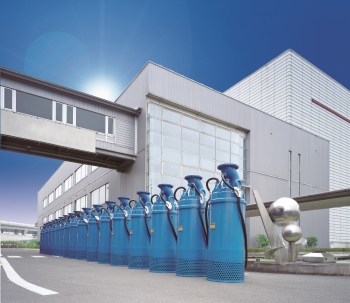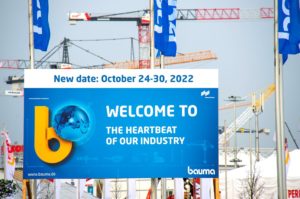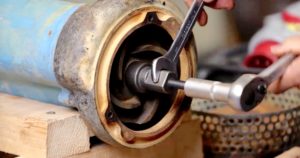Deep Pits Are a Challenge for Equipment: Drainage Water Under High Pressure
The deeper the pit, the more difficult the dewatering process: When conventional pumps reach their limits, often only a multi-level solution can help. The global race to secure scarce resources is well underway. Deposits are now being mined that could not have been reached or were not economically viable a few years ago. Also, infrastructure projects are becoming increasingly ambitious, one example being the Gotthard base tunnel. This poses great challenges with respect to the dewatering processes.

Multi-level high-pressure pump of the type LH4110W, in a line in front of the Tsurumi plant in Kyoto (Image: Tsurumi)
Often, many distances simply cannot be bridged with conventional submersible pumps; it is the vertical distances in particular that are decisive here. Most pumps can only pump up to heights of between 10 and 40 metres: but even these values are relative. In practice, they can only lift a small part of the stated maximum pumping capacity to this height, because height and capacity are intricately connected: the higher the height, the less water passes.
Switching pumps in series
Some operators work around this problem by using a series of pumps: two pumps that are operated sequentially in one section. This will almost double the achievable distance, although the pumping capacity remains the same. Usually, hoses are fitted between the aggregates. The problem with this concept is the same core risk associated with all complex systems: (too) many components are involved, some of which might not be in their best condition, are not installed to the optimum or simply should not have been combined in the first place.
The process can be enhanced by using an adapter manufactured by the pump manufacturer Tsurumi that allows two identical pumps to be directly coupled to create a kind of ‘super pump’. Nevertheless: the limiting factor here is the physics of the speed and impeller, which is why the pump programs of most manufacturers end at this point.
If this is insufficient for the dewatering process, things become difficult for tunnel builders and miners. In contrast to clear water, there are few pumps in the dewatering field that can improve the output noticeably.
Multi-level pumps
High-pressure pumps are then the optimum choice. For instance, the LH series by Tsurumi basically covers the pumping height range from 42 to more than 100 m. This is where classic pump designs reach their physical limits.
Another pump concept is required if you want to go any higher – you need multi-level pumps. From a technological point of view, this means that several impellers are mounted inside the casing. Whilst the pumping capacity remains the same, the pumping height increases with the number of these levels: The pump supplies more pressure and is therefore able to reach a higher head. As simple as the idea sounds, it is very difficult to realise if the pumped water contains solid matter.
Tsurumi from Japan seems to be the only supplier of these kinds of dewatering pumps in the world. These models are marked with a ‘W’ in the product catalogue. The LH4110W is the premium model. It is able to pump waste water vertically to a height of 216 m. To put this into perspective: this is higher than from the base to the viewing platform of the Berlin Television Tower. The aggregate can move 400 l/min. If requirements are lowered, for instance to a pumping height of 170 metres, the pumping output is increased five-fold to 2000 l/min. The power required for this is generated by a 110 kW motor. If two of these 1825 x 616 mm large monsters with a dry weight of 1270 kg were combined, a 432 m deep pit could be supplied with the smallest amount of conceptual effort.
Extreme: Mega pumps in sequence
These huge high-pressure pumps also comprise elements used in conventional pumps that have made this manufacturer a global leader in the construction pump market: Ultra-hard materials, clever cooling systems, dry-running-proof forced lubrication, individually cast conductors. ‘Stronger for longer’ is the slogan of this Japanese company that only opened its European headquarters in Düsseldorf, Germany, 35 years ago. The customer does not have to wait long: Whilst it is normal in the industry to wait weeks or even months for orders to be completed, this Japanese manufacturer is able to supply a large part of its product range within 24 hours thanks to an enormous central warehouse.
Due to the fact that there are simply no alternatives, multi-level dewatering pumps are not just the ultimate technical solution, they are also the only option available to users with high performance requirements who are seeking to design dewatering processes that are compact and fail-safe.
Source: Tsurumi (Europe) GmbH




